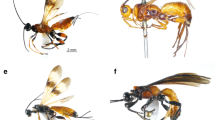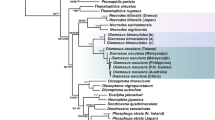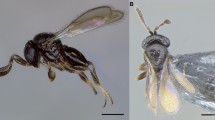Abstract
Spodoptera marima (Schaus, 1904) and Spodoptera ornithogalli (Guenée, 1852) are noctuid moths recognized for their economic importance in the New World. Historically, they have been considered cryptic species, being supposedly differentiated from each other by the absence of sexual dimorphism in S. marima, subtle differences in coloration on the hindwings and scale tufts of the ovipositor and the shape of male valva. The species are allopatric: North and Central America for S. ornithogalli and South America for S. marima. Previous phylogenetic studies using multilocus DNA sequences including a few specimens of S. marima suggested these species merge into a single clade. Here, we performed a comparative analysis to elucidate further their taxonomic status, using specimens of S. marima from various localities in Brazil. These species were recovered in the phylogenetic analysis as consistently mixed with each other in a major well-supported clade within Spodoptera. The existence of a spatial pattern for genetic structure was not clearly supported when two biogeographic regions (Neotropics and Neartic) were taken in separation; however, an individual-level isolation by distance was significant. The morphological characters traditionally used to differentiate the species were also not consistent. Therefore, we now consider S. marima a new junior synonym of S. ornithogalli. Results on host plant use demonstrated that it is a polyphagous species using more than 200 plants, which may mediate phenotypic variation along its geographical range.









Similar content being viewed by others
References
Bandelt HJ, Forster P, Röhl A (1999) Median-joining networks for inferring intraspecific phylogenies. Mol Biol Evol 16:37–48
Barnes W, Benjamin FH (1923) Nomenclature notes and new species. Contrib Nat Hist Lepidoptera N Amer 5:52–96
Barros EM, Torres JB, Ruberson JR, Oliveira MD (2010) Development of Spodoptera frugiperda on different hosts and damage to reproductive structures in cotton. Entomol Exp Appl 137:237–245. https://doi.org/10.1111/j.1570-7458.2010.01058.x
Bernarys EA, Singer M (2002) Contrasted foraging tactics in two species of polyphagous caterpillars. Acta Zool Acad Sci Hung 48:117–135
Biezanko CM, Ruffinelli A, Link D (1974) Plantas y otras sustancias alimenticias de las orugas de los lepidopteros uruguayos. Rev Cen Ciênc Rur 4:107–148
Boisduval JBAD, Guenée A (1852) Histoire Naturelle des Insectes. Species Général des Lépidoptères. Tome Cinquiéme. Noctuélites Tome 1. Paris, p 407
Capinera JL (2001) Handbook of vegetable pests. Academic Press, San Diego, p 729
Capinera JL (2008) Yellowstriped armyworm, Spodoptera ornithogalli (Guenée) (Lepidoptera: Noctuidae). In: Capinera JL (ed) Encyclopedia of entomology 2nd Ed. Vol. 4 (S-Z). Springer, Dordrecht, pp 4300–4302
Casmuz A, Juárez ML, Socías MG, Murúa MG, Prieto S, Medina S, Willink E, Gastaminza G (2010) Revisión de los hospederos del gusano cogollero del maíz, Spodoptera frugiperda (Lepidoptera: Noctuidae). Rev Soc Entomol Argent 69:209–231
Comstock JA (1965) Ciclo biologico de Prodenia ornithogalli Guenée (Lepidoptera: Noctuidae). Anal Inst Biol, Serie Zoologia 36: 199–202
Crumb SE (1929) Tobacco cutworms. U.S. Department of Agriculture Technical Bulletin 88, p 179
Crumb SE (1956) The larvae of the Phalaenidae. U.S. Department of Agriculture Technical Bulletin 1135, p 356
Dias FMS, Specht A, San Blas G, Casagrande MM, Mielke OHH (2017) Resurgence of a forgotten southern Brazil endemic species: taxonomic position, redescription, and spatio-temporal distribution of Porosagrotis carolia Schaus, 1929 (Lepidoptera: Noctuidae: Noctuinae). Zootaxa 4363:421–433
Dumas P, Barbut J, Le Ru B, Silvain JF, Clamens AL, d’Alençon E et al (2015) Phylogenetic molecular species delimitations unravel potential new species in the pest genus Spodoptera Guenée, 1852 (Lepidoptera, Noctuidae). PLoS One 10:e0122407. https://doi.org/10.1371/journal.pone.0122407
Excoffier L, Lischer HEL (2010) Arlequin suite ver 3.5: a new series of programs to perform population genetics analyses under Linux and Windows. Mol Ecol Res 10:564–567
Fernández LS, Fernández CR, Mejía JE (2004) Ciclo de vida de Spodoptera ornithogalli (Guenée) en el cultivo del algodonero en el Valle Medio del Sinú. Temas Agrarios 9:30–36
Ferguson DC, Hilburn DJ, Wright B (1991) The Lepidoptera of Bermuda: their food plants, biogeography, and means of dispersal. Mem Ent Soc Can 158:1–105
Folmer O, Black M, Hoeh W, Lutz R, Vrijenhoek R (1994) DNA primers for amplification of mitochondrial cytochrome c oxidase subunit I from diverse metazoan invertebrates. Mol Mar Biol Biotechnol 3:294–299
Gomez-Rolim AAS, Yano SAC, Specht A, Andrade CGTJ, Sosa-Gómez DR (2013) Morphological and molecular characterization of the eggs of some noctuid species associated with soybean in Brazil. Ann Entomol Soc Am 106:643–651. https://doi.org/10.1603/AN13049
Guevara SJD, Granda G (2009) Noctuidae y los cultivos agroforestales en el Ecuador. Nuestra Ciência 11:22–25
Guindon S, Dufayard JF, Lefort V, Anisimova M, Hordijk W, Gascuel O (2010) New algorithms and methods to estimate maximum-likelihood phylogenies: assessing the performance of PhyML 3.0. Syst Biol 59:307–321
Hallman G (1979) Importancia de algunas relaciones naturales plantas-artrópodos en la agricultura de la zona cálida del Tolima Central. Rev Colomb Entomol 5:19–26
Harvey LF (1875) Observations on North American moths. Bull Buffalo Soc Nat Sci 2:270–284
Hebert PDN, Cywinska A, Ball SL, Dewaard JR (2003) Biological identifications through DNA barcodes. Proc Roy Soc (London), Series B: Biological Sciences 270:313–321
Hebert PDN, deWaard JR, Landry J-F (2010) DNA barcodes for 1/1000 of the animal kingdom. Biol Lett 6: 359-362
Heppner JB (2007) Lepidoptera of Florida. Part 1. Introduction and catalog. Florida Department of Agriculture & Consumer Services, Gainesville, p 670
Kergoat GJ, Prowell DP, Le Ru BP, Mitchell A, Dumas P, Clamens AL, Condamine FL, Silvain JF (2012) Disentangling dispersal, vicariance and adaptive radiation patterns: a case study using armyworms in the pest genus Spodoptera (Lepidoptera: Noctuidae). Mol Phylogenet Evol 65:855–870
King EW (1981) Rates of feeding by four lepidopterous defoliators of soybeans. J Georgia Entomol Soc 16:283–288
Jorge RL, Cordeiro-Estrela P, Klaczko LB, Moreira GRP, Freitas AVL (2011) Host-plant dependent wing phenotypic variation in the Neotropical butterfly Heliconius erato. Biol J Linn Soc 102:765–774
Montezano DG, Specht A, Sosa-Gómez DR, Roque-Specht VF, Bortolin TM, Fronza E, Pezzi P, Luz PC, Barros NM (2013) Immature stages of Spodoptera albula (Walker) (Lepidoptera: Noctuidae): developmental parameters and host plants. An Acad Bras Cienc 85:271–284
Montezano DG, Specht A, Sosa-Gómez DR, Roque-Specht VF, Barros NM (2014) Immature stages of the armyworm, Spodoptera eridania: developmental parameters and host plants. J Insect Sci 14:1–11
Montezano DG, Sosa-Gómez DR, Paula-Moraes SV, Roque-Specht VF, Fronza E, Barros NM, Specht A (2015) Biotic potential and reproductive parameters of Spodoptera dolichos (Fabricius, 1794) (Lepidoptera: Noctuidae), in the laboratory. Zoologia 32:485–491
Palmer WA (1987) The phytophagous insect fauna associated with Baccharis halimifolia L. and B. neglecta Britton in Texas, Louisiana, and northern Mexico. Proc Entomol Soc Washington 89:185–199
Parkman P, Shepard M (1981) Foliage consumption by yellowstriped armyworm larvae after parasitization by Euplectrus plathypenae. Fla Entomol 64:192–194
Passoa S (1991) Color identification of economically important Spodoptera larvae in Honduras (Lepidoptera: Noctuidae). Insecta Mundi 5:185–196
Pastrana JA (2004) Los Lepidópteros Argentinos: sus plantas hospedadoras y otros substratos alimenticios. Sociedad Entomológica Argentina, Buenos Aires, p 334
Pogue M (2002) A world revision of the genus Spodoptera Guenée (Lepidoptera: Noctuidae). Mem Amer Entomol Soc, Philadelphia, p 202
Posada D (2008) jModelTest: phylogenetic model averaging. Mol Biol Evol 25:1253–1256
Ribeiro LP, Costa EC (2008) Ocorrência de Erinnyis ello e Spodoptera marima na cultura da mamona no Rio Grande do Sul. Cienc Rural 38:2351–2353
Rings RW (1977) An illustrated field key to common cutworms, armyworms and looper moths in the north central states. Ohio Agn Res and Dev Center Cir 227:60
Robinson GS, Ackery PR, Kitching IJ, Beccaloni GW, Hernández LM (2010) HOSTS - A Database of the World’s Lepidopteran Hostplants. Natural History Museum, London. http://www.nhm.ac.uk/hosts / Accessed 18 Aug 2010
Rodrigues D, Moreira GRP (2002) Geographical variation in larval host-plant use by Heliconius erato (Lepidoptera: Nymphalidae) and consequences for adult life history. Braz J Biol 62:321–332
Rousset F (1997) Genetic differentiation and estimation of gene flow from F-statistics under isolation by distance. Genetics 14:1219
Rotter MC, Holeski LM (2017) The lepidopteran herbivores of the model plant Mimulus guttatus. J Lepid Soc 71:162–168
Rozas J, Ferrer-Mata A, Sánchez-DelBarrio JC, Guirao-Rico S, Librado P, Ramos-Onsins SE, Sánchez-Gracia A (2017) DnaSP 6: DNA sequence polymorphism analysis of large datasets. Mol Biol Evol 34:3299–3302. https://doi.org/10.1093/molbev/msx248
Sanzana MJ, Parra LE, Sepulveda-Zuniga E, Benitez HA (2013) Latitudinal gradient effect on the wing geometry of Auca coctei (Guerin) (Lepidoptera, Nymphalidae). Rev Bras Entomol 57:411–416
Schaus W (1904) New species of American Heterocera. Trans Amer Entomol Soc 30:135–178
Silva AGA, Gonçalves CR, Galvão DM, Gonçalves AJL, Gomes J, Silva MN, Simoni L (1968) Quarto catálogo dos insetos que vivem nas plantas do Brasil: seus parasitos e predadores. Ministério da Agricultura, Rio de Janeiro, p 622 (Parte II, 1° tomo, Insetos, hospedeiros e inimigos naturais)
Specht A, Silva E, Link D (2004) Noctuídeos (Lepidoptera, Noctuidae) do Museu Entomológico Ceslau Biezanko, Departamento de Fitossanidade, Faculdade de Agronomia “Eliseu Maciel”, Universidade Federal de Pelotas, RS. R Bras Agrociênc 10:389–409
Specht A, Teston JA, Di-Mare RA, Corseuil E (2005) Noctuídeos (Lepidoptera, Noctuidae) coletados em quatro Áreas Estaduais de Conservação do Rio Grande do Sul, Brasil. Rev Bras Entomol 49:130–140. https://doi.org/10.1590/S0085-56262005000100015
Specht A, Roque-Specht VF (2016) Immature stages of Spodoptera cosmioides (Lepidoptera: Noctuidae): developmental parameters and host plants. Zoologia 33. https://doi.org/10.1590/S1984-4689zool-20160053
Swofford DL (2002) ‘PAUP* phylogenetic analysis using parsimony (* and other methods). Version 4.’ Sinauer associates: Sunderland
Tamura K, Stecher G, Peterson D, Filipski A, Kumar S (2013) MEGA 6: molecular evolutionary genetics analysis, version 6.0. Mol Biol Evol 30:2725–2729
Todd EL, Poole RW (1980) Keys and illustrations for the armyworm moths of the Noctuid genus Spodoptera Guenée from the western hemisphere. Ann Entomol Soc Am 73:722–738
USDA (2017) U.S. Department of Agriculture. https://plants.usda.gov/java/ Accessed 1 Dec 2017
Van de Vossenberg BT, Van der Straten MJ (2014) Development and validation of real-time PCR tests for the identification of four Spodoptera species: Spodoptera eridania, Spodoptera frugiperda, Spodoptera littoralis, and Spodoptera litura (Lepidoptera: Noctuidae). J Econ Entomol 107:1643–1654
Wagner DL, Schweitzer DF, Sullivan JB, Reardon RC (2011) Owlet caterpillars of eastern North America. Princeton University Press, Princeton, p 576
Weir BS, Cockerham CC (1984) Estimating F-statistics for the analysis of population structure. Evolution 38:1358–1370
Zahiri R, Lafontaine JD, Schmidt BC, Dewaard JR, Zakharov EV, Hebert PD (2014) A transcontinental challenge - a test of DNA barcode performance for 1,541 species of Canadian Noctuoidea (Lepidoptera). PLoS One 9:e92797. https://doi.org/10.1371/journal.pone.0092797
Acknowledgments
We are especially grateful to all of those involved with field collections of specimens used in this study: Adriano Q. Mesquita, Américo I. Ciociola Júnior, André L. Filipiake, Antônio C.S. Araújo, Balbino A. Evangelista, Brenda M. Moreira, Daniel B. Fragoso, Daniel R. Sosa-Gomez, Denivaldo C. Castro, Dirceu Pratissoli, Elisângela G.F. Morais, Erivaldo A. Santos, Felipe O. Mateus, Harry Ebert, João B.G. Santos Filho, Jorge U. P. Corrêa, José A. Teston, José R. Carvalho, José S. Zanúncio Júnior, Leonardo Mardgan, Maicon Coradini, Marco A.P. Silva, Marcos R.O. Serpa, Murilo Fazolin, Naylor B. Perez, Oriverto Tonon, Paulo R.V.S. Pereira, Rafael M. Pitta, Rinaldo J. Silva Júnior, Rodison N. Sisti, Sandra M.M. Rodrigues, Tiago C. C. Lima, Vander C.M. Claudino, and Wilson Pozenato. We acknowledge Tiago Ferraz for helping with the DNA extraction. We thank Andrew Warren and Paul Z. Goldstein for providing photos and information about the types deposited at MGCL and USNM. We also thank Crisla Maciel for helping with statistical analysis and Lafayette Eaton for editing the text. Conselho Nacional de Desenvolvimento Científico e Tecnológico – CNPq: AS (processo no. 306601/2016-8); MMC (processo 308247/2013-2); OHHM (processo no. 304639/2014-1); for fellowships and research funds (processo no. 403376/2013-0), and Empresa Brasileira de Pesquisa Agropecuária - Embrapa (SEG MP2 n° 02.13.14.006.00.00) partially funded this study. Coordenação de Aperfeiçoamento de Pessoal de Nível Superior – CAPES (Edital Capes-Embrapa no. 15/2014 - Proposta 92) provided fellowships to RB, EC and FLS. Fundação de Amparo a Pesquisa do Rio Grande do Sul (FAPERGS) together with CNPq via PRONEX project provided a DTI-2 research fellowship to GLG. We are also grateful to ICMBio and MMA for the Authorizations for Scientific Activities (SISBIO no. 48218-3 and 38547/6).
Author information
Authors and Affiliations
Contributions
AS, GRPM, and MMC—conceived and designed the study; AS, EC, FLS, and RB—carried out field collection and laboratory experiments; GLG—performed DNA extraction, sequencing, and molecular analysis; AS, GLG, GRPM, MMC, RB, and VFR-S—wrote the manuscript with input from all authors. AS, EC, FLS, GLG, GRPM, MMC, OHHM, and VFR-S—discussed the results and contributed to the final manuscript.
Corresponding author
Additional information
Edited by Andre VL Freitas – Unicamp
Publisher’s note Springer Nature remains neutral with regard to jurisdictional claims in published maps and institutional affiliations.
Rights and permissions
About this article
Cite this article
Brito, R., Specht, A., Gonçalves, G.L. et al. Spodoptera marima: a New Synonym of Spodoptera ornithogalli (Lepidoptera: Noctuidae), with Notes on Adult Morphology, Host Plant Use and Genetic Variation Along Its Geographic Range. Neotrop Entomol 48, 433–448 (2019). https://doi.org/10.1007/s13744-018-0654-z
Received:
Accepted:
Published:
Issue Date:
DOI: https://doi.org/10.1007/s13744-018-0654-z




